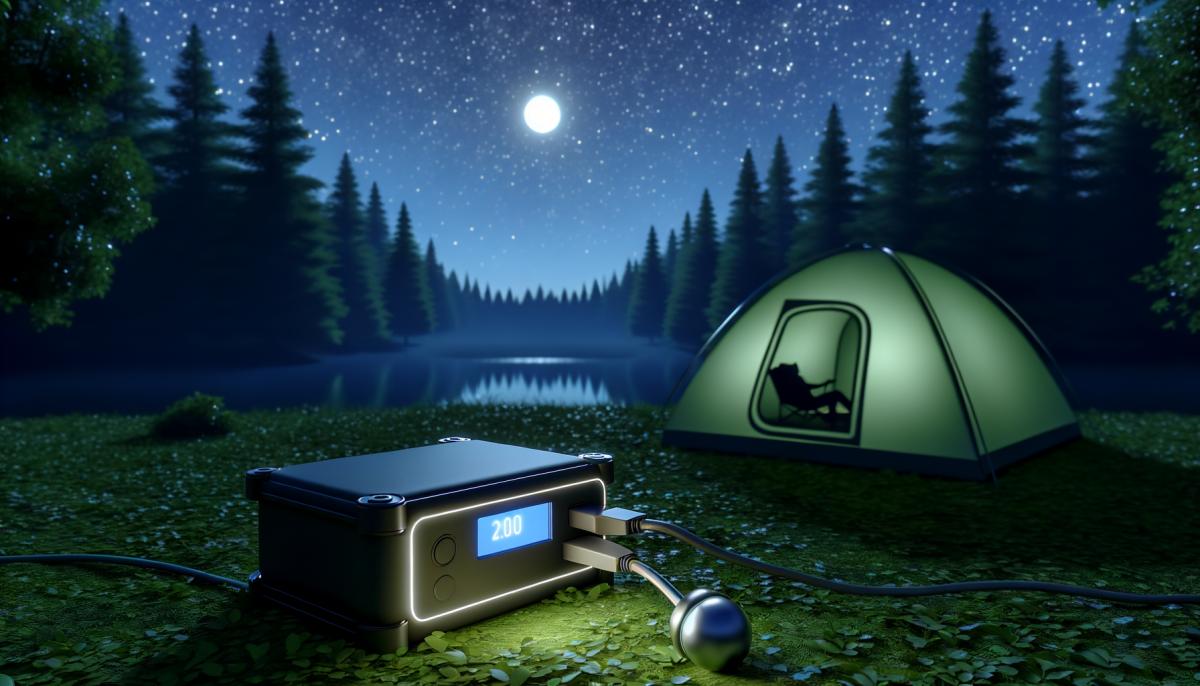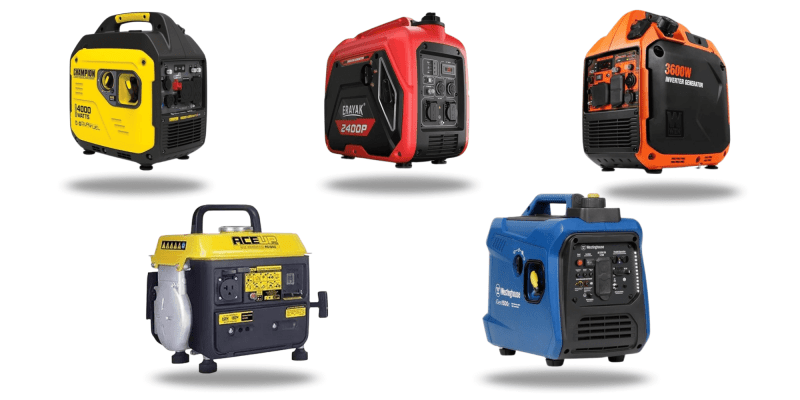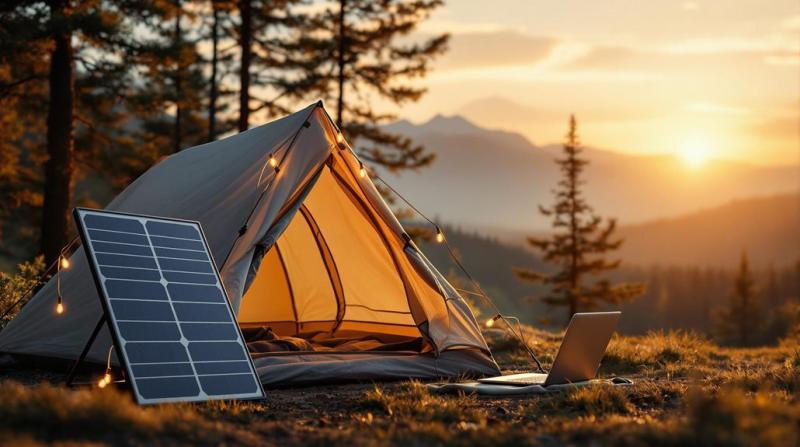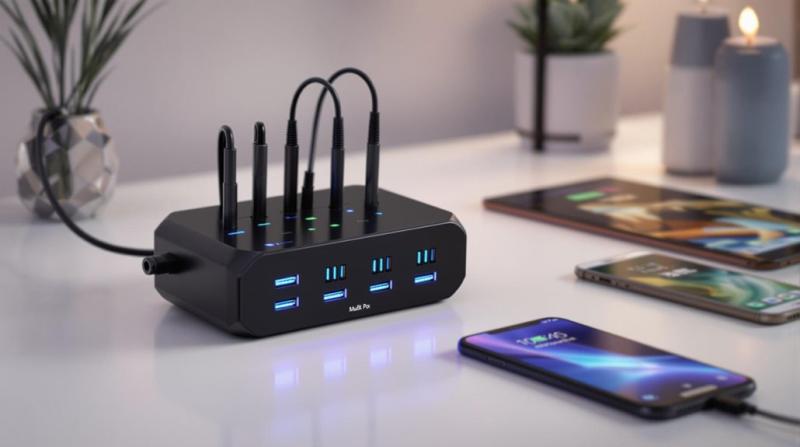To get the most out of your camping power station, try to keep its charge levels between 20% and 80%. This helps avoid both degradation and deep discharge damage.
Next, store your power station in a cool, dry place—somewhere between 15°C and 25°C is perfect. Always follow the manufacturer's guidelines to make sure it doesn't overheat.
It's a good habit to clean your power station regularly. A little dusting can go a long way! And when it hits 100% charge, unplug it to prevent overcharging.
Also, keep an eye on the state of charge and state of health using the built-in Battery Management System (BMS).
By sticking to these tips, you'll keep your power station in great shape for all your camping adventures!
Battery Life Essentials
Taking good care of your camping power station's battery is super important if you want it to last a long time and work well. One easy trick is to keep the charge between 20% and 80%. This little tip helps protect the battery from getting too low or too high, which can mess it up over time.
Another thing you can do is check and recharge the battery every few months, even if you're not using it. This way, you avoid losing capacity from just letting it sit there.
Now, let's talk about chargers. Using a high-quality charger is a game-changer. Always follow the manufacturer's guidelines when charging. Overcharging or letting the battery go completely flat can do some serious damage.
And where you store your power station matters too. Keep it in a cool, dry spot, ideally between 15°C and 25°C (that's 59°F to 77°F).
One more thing to keep an eye on is the battery's state of charge (SoC) and state of health (SoH). Your power station probably has a built-in Battery Management System (BMS) that helps with this. It can spot potential issues and give you important info for keeping things running smoothly.
Following these tips will help your battery stay in top shape, making your camping trips a lot more enjoyable!
Charging and Maintenance
To safeguard your camping power station's battery, it's super important to stick to proper charging and maintenance routines. These habits really help keep the battery healthy and performing well.
First off, make sure you charge your station within the sweet spot temperature range of 20°C to 25°C (68°F to 77°F). This helps prevent overheating and ensures your battery lasts longer. Also, don't forget to unplug the power station once it hits 100% capacity to avoid overcharging, which can wear down the battery over time.
Ever heard of the 20-80 charging rule? It's a game-changer for battery life. Basically, keep your charge level between 20% and 80%. This way, you avoid deep discharge damage.
And don't skip on regular maintenance. If you're not using your power station, check and maintain the battery's charge level every few months. This helps prevent deep discharge damage and battery failure. For long-term storage, keep your power station in a cool, dry place and aim for around 50% charge. This minimizes capacity loss and keeps the battery in good shape.
It's also crucial to keep your camping power station clean. Dust and dirt can cause overheating, so give it a good wipe-down now and then. Plus, inspect the cables for any damage.
Charging it periodically is key too. Letting it completely discharge can be harmful.
Following these easy steps can seriously boost your power station's performance and battery life.
Temperature and Storage
When you're stashing away your camping power station, make sure it hangs out in a cool, dry spot. Ideally, you want to keep the temperature between 15°C and 25°C (59°F to 77°F). This sweet spot helps prevent battery degradation. Basically, it slows down those pesky chemical reactions inside the battery that can wear it out. Keeping it in this range means your power station will stay reliable and last longer.
Now, don't let your power station face extreme temperatures. High heat can speed up battery aging and cut down its overall capacity. If you're storing it for a long time, keep the battery charge at around 50%. This helps preserve its health and avoids damage from deep discharging. At 50%, the battery keeps some juice without stressing out too much.
Remember to check the humidity levels where you're storing your power station. Too much moisture can mess with the battery's performance and lifespan.
Every 3-6 months, give your power station a look and maybe a little recharge. This keeps the battery in top shape and ready to go when you need it. Following these tips will protect your investment and ensure your camping power station works like a charm when you need it most.
Power Management Techniques
By spreading out high-energy device usage throughout the day, you can avoid overloading your camping power station and really extend the battery's lifespan. It's super important to have a well-planned power management system to get the most out of your battery.
One great trick is to use energy-saving settings on your devices. For example, turn on power-saving modes on your laptop and smartphone. This helps cut down on overall power draw during your camping trips.
Keeping an eye on your battery levels is a must. Make sure to recharge your power station when the charge drops below 20%. This prevents deep discharges, which can really shorten your battery's life.
Also, be sure to turn off any features and devices you're not using. This helps to minimize idle power drain and ensures you're conserving energy for the important stuff.
Using smart plugs can make your power management even better. They let you control power usage remotely and automatically shut off devices when they're not needed. This is super handy for extending your battery life during your camping adventures.
Monitoring and Troubleshooting
So, you're troubleshooting your camping power station, huh?
First things first, you gotta identify any battery performance issues and figure out if you've got any faulty cells.
Keeping an eye on the battery's state of charge and health is key. This way, you can spot potential problems before they turn into bigger headaches.
Plus, doing regular inspections and checking out those error codes will help you catch any weird stuff early on.
That way, you can take action and keep your battery running longer.
Battery Performance Issues
When you're out camping, the last thing you want to worry about is your power station's battery giving up on you. So, making sure your battery lasts as long as possible is super important.
To keep things running smoothly, keep an eye on the state of charge (SoC) and state of health (SoH) using your battery management system (BMS). It's kind of like a health check-up for your battery. Also, don't ignore any error codes or alerts from the system—these are like your battery's way of saying, 'Hey, something's wrong here!' If you notice your battery isn't lasting as long, isn't holding a charge, or starts to swell up, it might be time to think about getting a new one.
Taking care of your battery is key to making sure it performs well and lasts a long time. Make it a habit to check for error codes and listen to any alerts from the power station's management system.
Keeping the battery terminals and connections clean is also a good idea to prevent corrosion and ensure good conductivity. And hey, be smart about how you charge your battery. Avoid letting it drop below 20% if you can—this will help your lithium-ion batteries live longer.
Identifying Faulty Cells
Keeping an eye on your power station's battery is super important to avoid any nasty surprises. The first thing you should do is regularly check the battery management system (BMS) for any error codes or alerts. These will let you know if there are any cell malfunctions or imbalances. Catching these early means you can fix them before they turn into bigger problems.
Next, grab a multimeter and check the voltage of each cell. If you see even a tiny difference, like more than 0.1V, that can be a red flag for a faulty cell. You might need to dig deeper or even replace it. Also, keep an eye out for any physical signs of trouble. If a cell looks swollen or is leaking, it's definitely time to take action.
Another good idea is to run regular capacity tests. Fully charge and then discharge the unit under controlled conditions to see if the runtime matches what the manufacturer says it should be. This can give you a good indication that the cells are in good shape.
Don't forget to monitor your battery's state of health (SoH) and state of charge (SoC) using any compatible apps. Big drops in SoH can be a sign that cells are failing and need attention.
Energy Efficiency Strategies
Hey there! When you're out camping and want to make sure you're using your energy efficiently, there are a few tricks to keep in mind.
First off, swap out those old incandescent bulbs for LED lights. They use a lot less power—like, 75% less! This means your camping power station will last way longer.
Another thing you can do is turn on power-saving modes on your gadgets like laptops and smartphones. Trust me, it makes a big difference. These modes can cut energy use by up to 30% when your devices are just sitting around.
And don't forget, unplug chargers and devices when you're not using them. That sneaky phantom energy consumption can actually waste up to 10% of your total energy! Crazy, right?
Make sure you charge your essential devices first thing in the day, and try to spread out the use of high-power stuff. This way, you won't drain your power station all at once.
Keep an eye on your power settings, too. Regular adjustments can help you save even more energy, making your battery last longer on your trip.
Safe Replacement and Disposal
Before we get into how to replace the battery in your camping power station, let's make sure we're all on the same page about safety. Seriously, following safety guidelines is key to avoiding any nasty surprises and making sure the battery swap goes smoothly.
First off, check the manufacturer's specs for the replacement battery to make sure everything will work correctly. And, of course, unplug the power station from any power source to keep yourself safe from electric shocks and any potential damage.
Now, when you're handling the old battery, be careful and give it a good look-over for any signs of leakage or swelling. If you see anything like that, it's time to ditch that battery right away to avoid any safety issues.
And speaking of getting rid of the old battery, proper disposal is super important to keep our environment clean. Make sure to check out your local recycling regulations and follow them to a tee.
A lot of manufacturers have their own disposal programs or guidelines, so definitely take advantage of those. They make it easier to dispose of the battery responsibly. Just remember, improper disposal can create hazardous waste, so it's crucial to follow the right steps.



